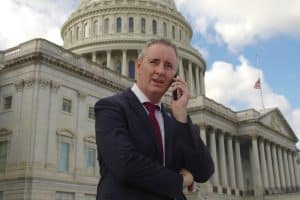Bucks County’s not doing well. Overall, if you have children and you live there there’s a 30 percent chance that you and your family are struggling. If you’re poor, your kids probably go to one of four school districts, while the individuals and families in the rest of Bucks County are gaining wealth at a rate disproportionate to your poverty. All of this despite the fact that the adult residents of the area are generally better educated than the national average. These data points stem from the newest snapshot taken by Children First – the details of which are available in their February 2025 Report on Bucks County.
Formerly known as Public Citizens for Children and Youth, Children First – founded in the early 1980s – “works to improve the lives of our region’s children by developing initiatives and advocating for quality health care, childcare, public education and family stability.” Consequently, they regularly take snapshots of how the lives of children are impacted in eastern Pennsylvania and, by necessity, they learn important data about the parents raising those kids.
Over the years, the Bucks County Beacon has provided extensive coverage of the geographical wealth gap in the region. And this news outlet isn’t the only one paying attention. State Representative Jim Prokopiak, an attorney and prior Pennsbury School Board member first elected to the 140th district of the Pennsylvania general assembly by special election in early 2024, is paying close attention, too.
At first glance, Bucks County might serve as a microcosm of the United States as a whole. Pockets of vast wealth with movie stars taking up residence just a few miles away from children impacted by lead poisoning. But Prokopiak doesn’t see it that way. He doesn’t have a whole lot of those wealthy constituents in his district. “I represent a portion of lower Bucks County, which is predominantly working middle class.” And because of that, Prokopiak keeps his focus squarely on “increased education funding, and [the need to] make sure that we have access to affordable healthcare and good paying jobs.”
Because the lawmaker calls these basic economic issues his “priority number one,” he’s spent some time pouring over the Children First report. He says that when looking at the report, “you’ll see that basically much of the income disparity is in the lower end where I represent, so you know that’s really where I’m focused.”
That Lower Bucks County region is plagued by issues that don’t bode well for the kids who live there. While Upper Bucks has some poverty, it’s not concentrated the way it is in Bristol Township and other locales. And while about 40,000 persons live in poverty in the county – a lot more than that – more than 30 percent of the families with children, live below ALICE levels.
Because federal poverty standards have not changed since 1969, a new standard has been adopted to evaluate whether or not an individual or family can afford the costs of living in the 21st Century.
ALICE speaks to persons who are Assets Limited and Income Constrained though Employed, or what is more commonly referred to as the working poor. According to the report, “The average family of four in Bucks County would need to make $86,268 to afford the basics.” ALICE standards figure in costs like childcare for working parents – an expense not factored into poverty levels. Housing, food, transportation, healthcare, technology, and taxes are also figured in. And though support programs exist like Child Care Works, there are not enough subsidies to meet the need. The Children First report found that childcare is more expensive in Bucks County than in the rest of the commonwealth and subsequently, 52 percent of income eligible children cannot enroll because of “staffing and provider shortages.”
Nicole Featherman, executive director of Lifespan School and Daycare, explained that even though “we are the workforce behind the workforce,” childcare provider wages are low and she can’t compete for highly skilled employees. Featherman and her colleagues must hire inexperienced workers and invest in their training and certification, adding to the expense of each new educator. “We’re hiring for attitude and training for skill.”
Once trained, Featherman laments that the newly minted teaching professionals can get better wages and benefits working in the traditional K-12 education system. This creates turnover that necessitates more hiring.
She said that Lifespan struggles with ever-increasing insurance premiums and other fixed expenses, having no option but to pass those on to parents. For low-income families, there are few options for childcare because of an inadequate number of subsidies and these high costs of early education. The shortage translates to 977 Bucks County kids not getting needed childcare services. Consequently, parents have difficulty hanging onto steady employment. To compound the issue, Children First found that – much like the rest of the country today – fewer kids are immunized and insured than were before the pandemic. “This has presented problems on the ground. More children getting sick. More parents missing work.”
Children First found additional problems in the Bucks County school districts – five of which lack the necessary funding to “adequately educate each student.” Third graders are underperforming in reading and low wealth school district eighth graders are at a “crisis point” in math proficiency. Additionally, segregation is the byproduct of clustering children of color in “a few districts and charter schools.”
WATCH: Children First Bucks County Report Release in Bristol
Assistant Superintendent of Bristol Township School District Dr. Chris Polzer fears more trouble may be on the horizon. Bristol Township benefited from an influx of more than $1 million following Commonwealth Court Judge Renée Cohn Jubelirer’s ruling that Pennsylvania’s educational funding mechanisms “violated the state constitution.”
Prior to that, the district had to work creatively to pay their bills. If not for that influx from the state “that would have meant teachers losing their jobs.” But, should the White House follow through on proposed cuts, local tax increases – or fired teachers may be their only options.
Prokopiak agrees. “Every day people come into my office and complain about property taxes.” He says the education system affects every taxpayer and if there aren’t adequate funds coming down from state and federal coffers “tax increases hit harder in lower income places than they necessarily do in higher income places. The ability for people to stay in their homes as a senior or as a working-class family struggling to pay their mortgage” compounds things. Prokopiak added, “That increased tax is something that really limits a school board.”
When it comes to balancing a school district’s budget, education expenses must be cut one way or another. Polzer explained, “I’m not a municipality. I can’t not pave a road.”
Prokopiak knows his constituents in the 14oth District and he knows they’re struggling. “The report is not something, frankly, that’s a surprise to the residents of lower Bucks County.” He understands what needs to be done. And what happens in the next weeks, months and years of the new presidential administration could have long-ranging impacts.
Should the proposed Medicaid cuts go through, kids’ health – one of the faltering indicators in the Children First report – will suffer. Prokopiak warned that CHIP, the Children’s Health Insurance Program, would be “on the chopping block.” He added that CHIP, “allows pretty much any child in the state of Pennsylvania to be covered, however that program will be affected by federal cuts.”
And it won’t just hurt kids. Prokopiak says all Pennsylvanians who depend on federal dollars for basic needs are at risk.
“It would have a huge negative impact on Pennsylvania and lower Bucks County. You know we have a growing aging population in Pennsylvania and certainly in lower Bucks County and those people depend on Social Security and Medicare and Medicaid to provide their income and their healthcare,” he added.
What can be done about the perils listed in the Children First report and the additional threats coming down from Washington?
Prokopiak urges his constituents to, “Reach out to their representatives in Washington DC. Representative Fitzpatrick and Senators McCormick and Federman.” He says they should, “Voice their concerns, obviously. That’s the first step is ensuring that their representatives know how they feel.”
And whether or not the federal government meets their obligation, Prokopiak promises to uphold his commitment to the people of lower Bucks County.







